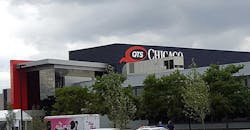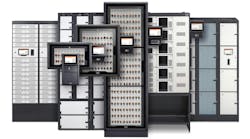The cloud has been gradually changing the shape of global networks. This trend is seen in the subsea cables that tie the Internet together, which are now often funded by hyperscale operators and come ashore near major cloud campuses. The architecture decisions of major cloud platforms also influence the locations where traffic is exchanged across networks.
Amazon Web Services has deployed components of its network infrastructure in QTS data centers in Chicago, Atlanta, and Piscataway, N.J., the companies said today. The “multi-megawatt” agreement provides AWs with high-density colocation space in three key markets, including infrastructure supporting interconnection for “a wide variety of AWS services,” providing network ingress/egress points for AWS customers and partners, as well as support for AWS’s Internet peering infrastructure and global backbone.
QTS says the deal is part of a shift away from traditional data hubs in major markets, as cloud players seek favorable economics and room for long-term growth for network infrastructure. The company says its growing hubs in Chicago and Atlanta provide “more robust alternatives to traditional metro interconnect facilities that are often constrained.”
The deployments track with Amazon Web Services’ expansion of its Local Zones program, in which AWS deploys edge infrastructure to help customers deploy low-latency applications in new markets.
Amazon operates a massive global network of data centers to power its cloud computing platform, with most of its capacity focused on clusters of large campuses in key network hubs. With Local Zones, AWS is creating a more distributed infrastructure to support edge computing and low-latency applications.
The AWS regional deployments align with the QTS’ ambitions to decentralize network architecture, moving beyond the traditional interconnection model. in which network hubs in the central business district large of major cities are the center of gravity for interconnection.
Sean Baillie, Executive Vice President, Connectivity at QTS, calls this the “carrier hotel dilemma.”
“Our vision for diverse connectivity hubs and ubiquitous, low-latency network access is top of mind for enterprise, hyperscale, and government customers and central to our business strategy,” said Baillie. “We are pleased to support network infrastructure for the world’s most scalable, secure, and reliable cloud.”
Making Interconnection More Distributed
Carrier hotels are large multi-tenant buildings where networks can connect, exemplified by buildings like 60 Hudson Street in New York, One Wilshire in Los Angeles, 350 Cermak in Chicago, and the Infomart in Dallas. These sites became the early cornerstones of the Internet economy, and some of the most successful properties in the colocation industry. A key piece of the business model is the meet-me room, a common area where providers can make connections between their networks.
QTS was among the founders of the Internet Ecosystem Innovation Committee (IEIC), an initiative to “geographically harden Internet infrastructure” by creating a more distributed network of interconnection hubs. Other founding members include executives from Google, IBM, Akamai, Interglobix, Ford, DE-CIX and Ciena. Much of the group’s early activity has been focused on promoting growth around the cable landing station in Virginia Beach, and the QTS campus near Richmond, about 100 miles inland.
There have also been efforts by Open-IX to create standards that make it easier to create Internet exchange facilities in new places, including multi-tenant wholesale data centers that seek to beef up their connectivity offerings.
Although there are reliability arguments for a more distributed interconnection system, there are also competitive aspects. Most carrier hotels are operated by a handful of large providers, including Digital Realty, CoreSite, Equinix, Netrality and several private owners.
The competitive power of Equinix in particular, and its interconnection ecosystem has long been the envy of competitors. Equinix was an early mover in shifting connections outside of major carrier hotels, most notably with its financial interconnection hubs in Secaucus, New Jersey.
Network decisions by global cloud operators like Amazon can have an impact. AWS is the most widely-used cloud platform, and low-latency “on ramps” to its infrastructure has become a key criteria for cloud-focused services and enterprises.
QTS believes the AWS deal begins to move the needle on distributed interconnection. Baillie says that growing clouds need more equipment space than is easily available in carrier hotels, which are often downtown towers with limited floor plates.
“I think that this is a validator that we’re on the right track,” said Baillie. “This is going to change the nature of big network exchanges in major US markets.”
About the Author



